7 books about van Riper, Charles
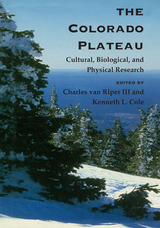
The Colorado Plateau
Cultural, Biological, and Physical Research
Charles van Riper
University of Arizona Press, 2004
Stretching from the four corners of Arizona, New Mexico, Colorado, and Utah, the Colorado Plateau is a natural laboratory for a wide range of studies. This volume presents 23 original articles drawn from more than 100 research projects presented at the Sixth Biennial Conference of Research on the Colorado Plateau. This scientific gathering revolved around research, inventory, and monitoring of lands in the region. The book's contents cover management techniques for cultural, biological, and physical resources, representing collaborative efforts among federal, university, and private sector scientists and land managers. Chapters on cultural concerns cover benchmarks of modern southwestern anthropological knowledge, models of past human activity and impact of modern visitation at newly established national monuments, challenges in implementing the 1964 Wilderness Act, and opportunities for increased federal research on Native American lands. The section on biological resources comprises sixteen chapters, with coverage that ranges from mammalian biogeography to responses of elk at the urban-wildland interface. Additional biological studies include the effects of fire and grazing on vegetation; research on bald eagles at Grand Canyon and tracking wild turkeys using radio collars; and management of palentological resources. Two final chapters on physical resources consider a proposed rerouting of the Rio de Flag River in urban Flagstaff, Arizona, and an examination of past climate patterns over the Plateau, using stream flow records and tree ring data. In light of similarities in habitat and climate across the Colorado Plateau, techniques useful to particular management units have been found to be applicable in many locations. This volume highlights an abundance of research that will prove useful for all of those working in the region, as well as for others seeking comparative studies that integrate research into land management actions.
[more]
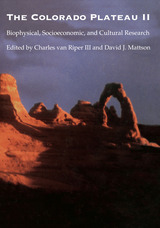
The Colorado Plateau II
Biophysical, Socioeconomic, and Cultural Research
Edited by Charles van Riper III and David J. Mattson
University of Arizona Press, 2005
The publication of The Colorado Plateau: Cultural, Biological, and Physical Research in 2004 marked a timely summation of current research in the Four Corners states. This new volume, derived from the seventh Biennial Conference on the Colorado Plateau in 2003, complements the previous book by focusing on the integration of science into resource management issues. The 32 chapters range in content from measuring human impacts on cultural resources, through grazing and the wildland-urban interface issues, to parameters of climate change on the Plateau. The book also introduces economic perspectives by considering shifting patterns and regional disparities in the Colorado Plateau economy. A series of chapters on mountain lions explores the human-wildland interface. These chapters deal with the entire spectrum of challenges associated with managing this large mammal species in Arizona and on the Colorado Plateau, conveying a wealth of timely information of interest to wildlife managers and enthusiasts. Another provocative set of chapters on biophysical resources explores the management of forest restoration, from the micro scale all the way up to large-scale GIS analyses of ponderosa pine ecosystems on the Colorado Plateau. Given recent concerns for forest health in the wake of fires, severe drought, and bark-beetle infestation, these chapters will prove enlightening for forest service, park service, and land management professionals at both the federal and state level, as well as general readers interested in how forest management practices will ultimately affect their recreation activities. With broad coverage that touches on topics as diverse as movement patterns of rattlesnakes, calculating watersheds, and rescuing looted rockshelters, this volume stands as a compendium of cutting-edge research on the Colorado Plateau that offers a wealth of insights for many scholars.
[more]
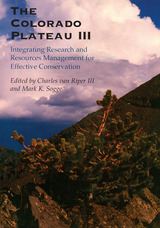
The Colorado Plateau III
Integrating Research and Resources Management for Effective Conservation
Edited by Charles van Riper III and Mark K. Sogge
University of Arizona Press, 2008
Roughly centered on the Four Corners region of the southwestern United States, the Colorado Plateau covers an area of 130,000 square miles. The relatively high semi-arid province boasts nine national parks, sixteen national monuments, many state parks, and dozens of wilderness areas. With the highest concentration of parklands in North America and unique geological and ecological features, the area is of particular interest to researchers. Derived from the Eighth Biennial Conference of Research on the Colorado Plateau, this third volume in a series of research on the Colorado Plateau expands upon the previous two books. This volume focuses on the integration of science into resource management issues, summarizes what criteria make a successful collaborative effort, outlines land management concerns about drought, provides summaries of current biological, sociological, and archaeological research, and highlights current environmental issues in the Four Corner States of Arizona, New Mexico, Colorado, and Utah. With broad coverage that touches on topics as diverse as historical aspects of pronghorn antelope movement patterns through calculating watershed prescriptions to the role of wind-blown sand in preserving archaeological sites on the Colorado River, this volume stands as a compendium of cuttingedge management-oriented research on the Colorado Plateau. The book also introduces, for the first time, tools that can be used to assist with collaboration efforts among landowners and managers who wish to work together toward preserving resources on the Colorado Plateau and offers a wealth of insights into land management questions for many readers, especially people interested in the natural history, biology, anthropology, wildlife, and cultural management issues of the region.
[more]
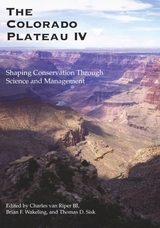
The Colorado Plateau IV
Shaping Conservation Through Science and Management
Charles van Riper
University of Arizona Press, 2010
Roughly centered on the Four Corners region of the southwestern United States, the Colorado Plateau covers some 130,000 square miles of sparsely vegetated plateaus, mesas, canyons, arches, and cliffs in Arizona, Utah, Colorado, and New Mexico. With elevations ranging from 3,000 to 14,000 feet, the natural systems found within the plateau are dramatically varied, from desert to alpine conditions.
This book focuses on the integration of science and resource management issues in this unique and highly varied environment. Broken into three subsections, this volume addresses conservation biology, biophysical resources, and inventory and monitoring concerns. The chapters range in content, addressing conservation issues—past, present, and future—on the Colorado Plateau, measurement of human impacts on resources, grazing and wildland-urban interfaces, and tools and methods for monitoring habitats and species.
An informative read for people interested in the conservation and natural history of the region, the book will also serve as a valuable reference for those people engaged in the management of cultural and biological resources of the Colorado Plateau, as well as scientists interested in methods and tools for land and resource management throughout the West.
This book focuses on the integration of science and resource management issues in this unique and highly varied environment. Broken into three subsections, this volume addresses conservation biology, biophysical resources, and inventory and monitoring concerns. The chapters range in content, addressing conservation issues—past, present, and future—on the Colorado Plateau, measurement of human impacts on resources, grazing and wildland-urban interfaces, and tools and methods for monitoring habitats and species.
An informative read for people interested in the conservation and natural history of the region, the book will also serve as a valuable reference for those people engaged in the management of cultural and biological resources of the Colorado Plateau, as well as scientists interested in methods and tools for land and resource management throughout the West.
[more]
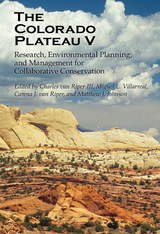
The Colorado Plateau V
Research, Environmental Planning, and Management for Collaborative Conservation
Edited by Charles van Riper III, Miguel L. Villarreal, Carena J. van Riper, and Matthew J. Johnson
University of Arizona Press, 2012
Roughly centered on the Four Corners region of the southwestern United States, the Colorado Plateau covers some 130,000 square miles of sparsely vegetated plateaus, mesas, canyons, arches, and cliffs in Arizona, Utah, Colorado, and New Mexico. With elevations ranging from 3,000 to 14,000 feet, the natural systems found within the plateau are dramatically varied, from desert to alpine conditions.
This volume, the fifth from the University of Arizona Press and the tenth overall, focuses on adaptation of resource management and conservation to climate change and water scarcity, protecting biodiversity through restructured energy policies, ensuring wildlife habitat connectivity across barriers, building effective conservation networks, and exploring new opportunities for education and leadership in conservation science.
An informative read for people interested in the conservation and natural history of the region, the book will also serve as a valuable reference for those people engaged in the management of cultural and biological resources of the Colorado Plateau, as well as scientists interested in methods and tools for land and resource management throughout the West.
This volume, the fifth from the University of Arizona Press and the tenth overall, focuses on adaptation of resource management and conservation to climate change and water scarcity, protecting biodiversity through restructured energy policies, ensuring wildlife habitat connectivity across barriers, building effective conservation networks, and exploring new opportunities for education and leadership in conservation science.
An informative read for people interested in the conservation and natural history of the region, the book will also serve as a valuable reference for those people engaged in the management of cultural and biological resources of the Colorado Plateau, as well as scientists interested in methods and tools for land and resource management throughout the West.
[more]
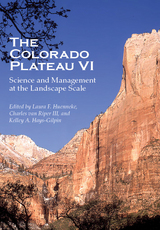
The Colorado Plateau VI
Science and Management at the Landscape Scale
Edited by Laura F. Huenneke, Charles van Riper III, and Kelley A. Hays-Gilpin
University of Arizona Press, 2015
Covering 130,000 square miles and a wide range of elevations from desert to alpine in Arizona, Utah, Colorado, and New Mexico, the Colorado Plateau has long fascinated researchers. The Colorado Plateau VI provides readers with a plethora of updates and insights into land conservation and management questions currently surrounding the region.
The Colorado Plateau VI’s contributors show how new technologies for monitoring, spatial analysis, restoration, and collaboration improve our understanding, management, and conservation of outcomes at the appropriate landscape scale for the Colorado Plateau. The volume’s chapters fall into five major themes: monitoring as a key tool for addressing management challenges, restoration approaches to improving ecosystem condition and function, collaboration and organizational innovations to achieve conservation and management objectives, landscape-scale approaches to understanding, and managing key species and ecological communities.
Focusing on the integration of science into resource management issues over the Colorado Plateau, this volume includes contributions from dozens of leading scholars of the region. The Colorado Plateau VI proves a valuable resource to all interested in the conservation management, natural history, and cultural biological resources of the Colorado Plateau.
The Colorado Plateau VI’s contributors show how new technologies for monitoring, spatial analysis, restoration, and collaboration improve our understanding, management, and conservation of outcomes at the appropriate landscape scale for the Colorado Plateau. The volume’s chapters fall into five major themes: monitoring as a key tool for addressing management challenges, restoration approaches to improving ecosystem condition and function, collaboration and organizational innovations to achieve conservation and management objectives, landscape-scale approaches to understanding, and managing key species and ecological communities.
Focusing on the integration of science into resource management issues over the Colorado Plateau, this volume includes contributions from dozens of leading scholars of the region. The Colorado Plateau VI proves a valuable resource to all interested in the conservation management, natural history, and cultural biological resources of the Colorado Plateau.
[more]
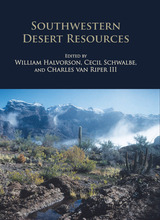
Southwestern Desert Resources
Edited by William Halvorson, Cecil Schwalbe, and Charles van Riper III
University of Arizona Press, 2010
The southwestern deserts stretch from southeastern California to west Texas and then south to central Mexico. The landscape of this region is known as basin and range topography featuring to “sky islands” of forest rising from the desert lowlands which creates a uniquely diverse ecology. The region is further complicated by an international border, where governments have caused difficulties for many animal populations.
This book puts a spotlight on individual research projects which are specific examples of work being done in the area and when they are all brought together, to shed a general light of understanding the biological and cultural resources of this vast region so that those same resources can be managed as effectively and efficiently as possible. The intent is to show that collaborative efforts among federal, state agency, university, and private sector researchers working with land managers, provides better science and better management than when scientists and land managers work independently.
This book puts a spotlight on individual research projects which are specific examples of work being done in the area and when they are all brought together, to shed a general light of understanding the biological and cultural resources of this vast region so that those same resources can be managed as effectively and efficiently as possible. The intent is to show that collaborative efforts among federal, state agency, university, and private sector researchers working with land managers, provides better science and better management than when scientists and land managers work independently.
[more]
READERS
Browse our collection.
PUBLISHERS
See BiblioVault's publisher services.
STUDENT SERVICES
Files for college accessibility offices.
UChicago Accessibility Resources
home | accessibility | search | about | contact us
BiblioVault ® 2001 - 2024
The University of Chicago Press









